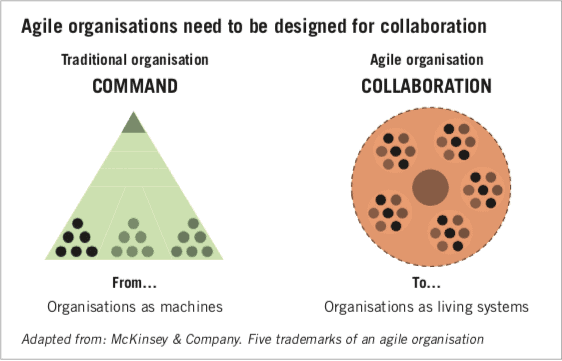
By Philip Atkinson
There is currently a significant wave of transformation across the life sciences sector.
Many organisations are evolving their processes and people capabilities to become more agile. The goal is to be more proactive to meet the needs of customers and to respond quickly to the new realities of society and business today.
Since the Industrial Revolution, organisations have attempted to control complexity by building a hierarchical, pyramid-shaped business structure. This was based on a hypothesis of command and control and a belief that solutions to problems should be found from within the organisation. The response to a competitive pressure was to increase the size of a department or create a new one. This created internal ‘silos’ competing for resources.
The leaders that succeeded in this model derived power from knowing more information than their teams ‘below’. Organisations often spent half a year planning a long-term strategy and budgets then implementing it on a linear annual timescale. Annual goals and performance metrics further reinforced established behaviours. When further growth was required, companies sought to acquire or merge with other similar companies – what Paul Simms from Eyeforpharma refers to as ‘marrying our cousins!’.
These pyramid structures are the antithesis of agile. As Frederic Laloux writes in Reinventing Organisations, ‘in pyramid structures, meetings are needed at every level to gather, package, filter and transport information as it flows up and down the chain of command’. This takes time, but in all areas of life we need to respond quickly to a stimulus – it hurts when we are kicked! There are many ‘kicks’ facing the industry: loss of patents, changes in regulatory, political and payer environments, not to mention the competitive pressures of smaller, faster competitors.

The smart movers are rethinking the way we work before we get kicked – perhaps even being agile enough to avoid them – this is the Agile Transformations we are experiencing in many leading organisations. Companies are being re- engineered to function more like a living system than a factory machine, with an open network of autonomous teams operating in rapid learning cycles.
The paradigm shift from a controlling hierarchy to empowered teams allows organisations to focus on creating value for all stakeholders and partners, including patients, customers and healthcare providers, not just shareholder value.
For an organisation to become more agile in a sustainable way there are two factors to consider; Process and People Capabilities. The methodologies of Sprints, Scrums and Fail-Fast, Learn-Quick processes can only be effective if they are supported by the right leadership mindsets and cultures. This requires a new, more sophisticated set of behavioural skills and ways of working (from the work of Uhl-Bien and Marion, Leadership in Complex Organisations).
Novartis CEO, Vas Narisimhan, has embraced this new approach to leadership with a programme called Un-Bossing. In a CNN interview he explains how the work of Michael Bunting and his powerful and insightful book, The Mindful Leader, underpins the Novartis model. Roche has also made a significant commitment to evolve its leadership capabilities and culture.
Cris Wilbur, Chief Human Resources Officer is quoted in an interview by Gallup, “Agility is both structural and cultural”. All leaders need to be more self aware of how their biases, beliefs and behaviours can support or hinder a culture of agility. A recent Healthcare Communication Association, HCA, Working Group, concurred. It identified leadership skills and behaviours as the most important factors for innovation and competitive advantage.
There are also important implications for agency/client partnerships. Agencies have always been great at adapting to client needs, usually by reacting to them and creating parallel structures of teams. With the focus on Sprints and Scrums, clients are forming small teams to focus on solving big problems quickly.
Agencies who are not part of that process and not familiar with the new client priorities and language risk being excluded. Other partners, positioning themselves as being experienced in Agility, will take preference. As clients may still be figuring this out for themselves and for their own organisations, the last people to be briefed and involved may be the established ‘trusted agency partners of record’. It is a wake up call that agencies need to heed.
We all need to be fit and flexible for the future. We all need to become more agile. Can your organisation or agency network even see its toes, let alone touch them?




